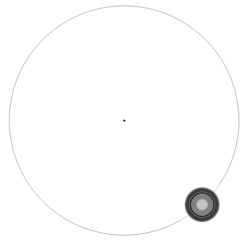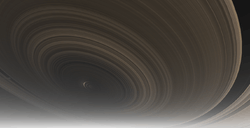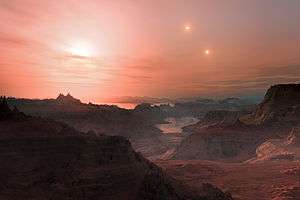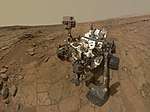V1400 Centauri
1SWASP J140747.93−394542.6 (also known as 1SWASP J140747, J1407 and Mamajek's Object) is a star similar to the Sun in the constellation Centaurus at a distance of about 434 light years from Earth.[3][5] A relatively young star, its age is estimated to be 16 million years, and its mass is about 90% that of the Sun.[1][6] The star has an apparent magnitude of 12.3 and requires a telescope to be seen.[2] The star's name comes from the SuperWASP (Wide Angle Search for Planets) program and the star's coordinates. The star is variable due to the planet orbiting around it and has been given the variable star designation V1400 Centauri.
 A graph of 1SWASP J1407 and J1407b to scale, showing the extent of the ring system | |
| Observation data Epoch J2000 Equinox J2000 | |
|---|---|
| Constellation | Centaurus |
| Right ascension | 14 07 47.93[1] |
| Declination | −39 45 42.7[1] |
| Apparent magnitude (V) | 12.31[1][2] |
| Characteristics | |
| Spectral type | K5 IV(e) Li[1] |
| Astrometry | |
| Proper motion (μ) | RA: −25.4±1.4[1] mas/yr Dec.: −20.1±3.5[1] mas/yr |
| Parallax (π) | 7.52±0.68[3] mas |
| Distance | 434±39[3] ly (133±12[3] pc) |
| Details | |
| Mass | 0.9[1] M☉ |
| Radius | >0.93±0.02[4] R☉ |
| Temperature | 4400±100[3] K |
| Age | 1.6×107[1] years |
| Database references | |
| SIMBAD | data |
| Extrasolar Planets Encyclopaedia | data |

In 2007, J1407 was observed to be eclipsed and orbited by at least one major body, 1SWASP J1407b[7] (J1407b), thought to be either a large gas giant planet or a brown dwarf with an immense ring system.[1][3][8] Subsequent observations have not successfully detected J1407b, suggesting that it is on a highly eccentric orbit around the star.[4]
1SWASP J140747.93−394542.6 b
The discovery of the J1407 system and its unusual eclipses were first reported by a team led by University of Rochester astronomer Eric Mamajek in 2012.[1] The existence and parameters of the ring system around the substellar companion J1407b were deduced from the observation of a very long and complex eclipse of the parent star lasting 56 days during April and May 2007.[1][6] The low-mass companion J1407b has been referred to as a "Saturn on steroids"[5][9] or “Super Saturn”[10] due to its massive system of circumplanetary rings with a radius of approximately 90 million km (0.6 AU).[3] The orbital period of J1407b is estimated to be around a decade (3.5 to 13.8 years), and its most probable mass is approximately 13 to 26 Jupiter masses, but with considerable uncertainty.[3] The ringed body can be ruled out as being a star with mass of over 80 Jupiter masses at greater than 99% confidence.[3] The ring system has an estimated mass similar to that of the Earth.[8] A major gap in the rings at about 61 million km (0.4 AU) from its centre is considered to be indirect evidence of the existence of an exomoon with mass up to 0.8 Earth masses.[3][11]
J1407b is the first exoplanet or brown dwarf discovered with a ring system by the transit method. A sequence of occultations (eclipses) of the star occurred over a 56-day period in 2007. The pattern was consistent with that expected for the transit of a large array of multiple rings, indicating the substellar companion dubbed “J1407b”.[1] The J1407b ring system has an outer radius of approximately 90 million km (about 640 times the extent of Saturn’s rings).[12] Cleared gaps in the rings indicate satellites (“exomoons”) have formed accreted from denser rings. The young age of the stellar system (about 16 million years) and the high mass of the ring system (roughly an Earth mass) are more consistent with it being an early (proto-)exomoon or moons, rather than a long-term stable ring system in an evolved planetary system (such as Saturn's rings).
J1407b has not been observed since its transit in 2007, suggesting that it is on a highly eccentric orbit around the star.[4] Such a highly eccentric orbit around the star could disrupt the ring system of J1407b.[5] Dynamical simulations ran by astronomers Steven Rieder and Matthew Kenworthy indicate that in order for J1407b's ring system to be stable, the rings must orbit J1407b in a retrograde motion, opposite to the direction J1407b orbits its host star.[4][5] This retrograde solution for the ring system of J1407b allows for longer ring lifetimes as well as further constraints to the age of the ring system.[4] The rings may be replenished over timescales as a result of processes that produce additional debris around J1407b, such as the tidal disruption of comets.[4]
From Earth's point of view, the ring system of J1407b would have an angular diameter of about 3.7 milliarcseconds across. For comparison, if Saturn were as many light years away, its rings in full breadth would be 0.006 milliarcseconds across.
| Companion (in order from star) |
Mass | Semimajor axis (AU) |
Orbital period (days) |
Eccentricity | Inclination | Radius |
|---|---|---|---|---|---|---|
| 1SWASP J1407b | 20.0±6.0 MJ | 3.9±1.7 | 3725±900 | <0.6 | — | — |
Notes
- 1.^ J1407b ring system diameter = 0.0000190 ly; distance = ~439 ly. 0.0000190/439=0.000000043 of the sky; 0.00000104 degrees; 0.000062 arcminutes; 0.00374 arcseconds; 3.74 milliarcseconds
Saturn's main ring system diameter (D-F rings) = 0.0000000296 ly; distance = 439 ly. 0.0000000296/439=0.0000000000674 of the sky; 0.00000000162 degrees; 0.000000097 arcminutes; 0.00000583 arcseconds; 0.00583 milliarcseconds
See also
References
- Mamajek, Eric E.; Quillen, Alice C.; Pecaut, Mark J.; Moolekamp, Fred; Scott, Erin L.; Kenworthy, Matthew A.; Collier Cameron, Andrew; Parley, Neil R. (March 2012). "Planetary Construction Zones in Occultation: Discovery of an Extrasolar Ring System Transiting a Young Sun-like Star and Future Prospects for Detecting Eclipses by Circumsecondary and Circumplanetary Disks". The Astronomical Journal. 143 (3): 72. arXiv:1108.4070. Bibcode:2012AJ....143...72M. doi:10.1088/0004-6256/143/3/72.
- "1SWASP J140747.93-394542.6". SIMBAD. Centre de données astronomiques de Strasbourg. Retrieved 2016-04-17.
- Kenworthy, Matthew A.; Mamajek, Eric E. (January 22, 2015). "Modeling giant extrasolar ring systems in eclipse and the case of J1407b: sculpting by exomoons?". The Astrophysical Journal. 800 (2): 126. arXiv:1501.05652. Bibcode:2015ApJ...800..126K. doi:10.1088/0004-637X/800/2/126.
- Rieder, Steven; Kenworthy, Matthew A. (21 November 2016). "Constraints on the size and dynamics of the J1407b ring system". Astronomy & Astrophysics. 596 (A9): A9. arXiv:1609.08485. Bibcode:2016A&A...596A...9R. doi:10.1051/0004-6361/201629567.
- St. Fleur, Nicholas (October 13, 2016). "Distant Ringed Object Could Be 'Saturn on Steroids'". New York Times. Retrieved October 14, 2016.
- "Eclipsing Ring System J1407". Cerro Tololo Inter-American Observatory. June 22, 2012. Retrieved January 27, 2015.
- "The Extrasolar Planet Encyclopaedia — 1SWASP J1407 b". Exoplanet.eu. 2014-10-29. Retrieved 2017-06-01.
- "Gigantic ring system around J1407b much larger, heavier than Saturn's". University of Rochester. January 26, 2015. Retrieved January 27, 2015.
- O'Neill, Ian (January 12, 2012). "'Saturn on Steroids' Exoplanet Discovered?". Discovery News. Retrieved January 27, 2014.
- Gigantic ring system around J1407b much larger, heavier than Saturn’s, on University of Rochester website.
- Sutton, P. J. (2019). "Mean motion resonances with nearby moons: an unlikely origin for the gaps observed in the ring around the exoplanet J1407b". Monthly Notices of the Royal Astronomical Society. 486 (2): 1681–1689. arXiv:1902.09285. Bibcode:2019MNRAS.486.1681S. doi:10.1093/mnras/stz563.
- Brumfield, Ben (2015-01-28). "Discovery: 'Super Saturn' with rings 200 times as big". CNN.com. Retrieved 2017-06-01.

